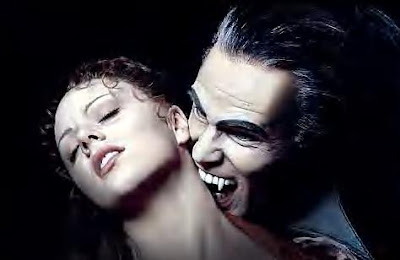 The first modern vampire was born at the same time as another great horror cliché: Frankenstein. While in Geneva, Switzerland, Lord Byron, Percy and Mary Shelley, and Byron’s doctor Polidori decided to write some ghost stories—yeah, they were doing it on a whim, while on vacation—and Mary Shelley indubitably won by writing the first science fiction novel ever. Polidori wrote The Vampyre—and he based it on Lord Byron himself.
The first modern vampire was born at the same time as another great horror cliché: Frankenstein. While in Geneva, Switzerland, Lord Byron, Percy and Mary Shelley, and Byron’s doctor Polidori decided to write some ghost stories—yeah, they were doing it on a whim, while on vacation—and Mary Shelley indubitably won by writing the first science fiction novel ever. Polidori wrote The Vampyre—and he based it on Lord Byron himself.Lord Byron was probably one of the world’s first literary bestsellers. He was famous for plenty of things: popularizing the bad boy persona, shaping modern tourism, but especially his sexual proclivities. So when the original vampire story was being written, the vampire took on Byron’s boisterous aristocratic mien—but also a lot of the “my love is fatal to my lover” mythology of Byron’s sexuality.
I guess it’s not that surprising that vampires are so sexualized—the idea of exchanging body fluids, the nearness that a bite has to a kiss, and the fact that the attacks always come at night all contribute to making the vampire the sexual monster. The sexuality of the vampire lies at the intersection of many deviances: the desire to love and to kill is akin to sadomasochism, the coldness of the undead force it into a distorted form of necrophilia, and when a vampire loves, he/she also “sires” (okay, Buffyspeak) a new vampire, making it a strange form of incest as well.
In popular works today, the vampire takes on other forms of deviance. In the first season of True Blood, the vampire stands in for the homosexual. The vampire stands in for all of these desires and more because the vampire is a being whose sexuality is at odds with the norms of society. Consequently, in later works (like Buffy and Twilight), an effort has to be made to sanitize the antisocial elements of the vampire: they need to hunt wild animals, they need to raid blood banks.

I hadn't realized how all the vampire stories started! That's awesome. I wonder if Lord Byron had any idea how much he would influence media SO many years later.
ReplyDeletenice work keep it up
ReplyDelete